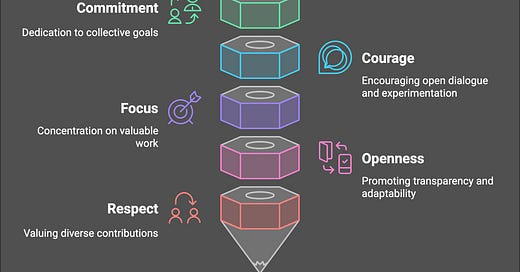Collaboration is the New Competitive Advantage
How Shifting from Rivalry to Teamwork Creates Stronger Leaders and More Innovative Teams
Today we’re teaming up with
on the topic of collaboration. Make sure to check out her publication . She touches on a range of topics around mental health, career evolution and empowering growth. It is a great read and I truly recommend it!Why Collaboration Over Competition Matters
In today’s fast-paced, results-driven world, competition is often seen as the fuel that drives success. But what if collaboration is the real game-changer? While competition can push individuals to excel, it often creates silos, discourages knowledge-sharing, and limits innovation.
True success, especially in leadership and team dynamics, comes from fostering a culture where collaboration isn’t just encouraged—it’s expected. High-performing teams don’t hoard information or operate in isolation. Instead, they thrive on trust, transparency, and shared goals.
Being collaborative can also help you grow into a leader, and we’ll explore a very personal story on that topic.
The Hidden Costs of Competition
A workplace culture that rewards individual competition over teamwork can lead to:
Knowledge Silos: Employees hold onto information to maintain an edge rather than share insights for collective growth.
Burnout and Low Morale: When individuals feel like they are constantly proving themselves against colleagues, it creates stress and disengagement.
Short-Term Wins, Long-Term Losses: While competition may drive quick results, it often undermines long-term stability, creating a revolving door of talent rather than a strong, resilient team.
Instead, leaders who cultivate collaboration create an environment where innovation flourishes, teams support one another, and success is shared rather than hoarded.
Overcoming Barriers to a Collaborative Culture
Despite the clear benefits of collaboration, shifting from a competitive to a cooperative mindset isn’t always easy. Here’s how leaders can break down common barriers:
Breaking Down Silos: Cross-functional collaboration should be the norm, not the exception. Leaders need to create structures—like shared goals, open communication channels, and regular knowledge-sharing sessions—to ensure teams work together rather than in isolation.
Managing Expectations and Accountability: Collaboration doesn’t mean a lack of accountability. Clear roles, responsibilities, and performance metrics are still critical, but they should be structured to encourage teamwork rather than individual rivalry.
Psychological Safety: The Foundation of Collaboration: People collaborate best when they feel safe to voice ideas, challenge assumptions, and admit mistakes without fear of judgment. Leaders must actively create an environment where transparency and trust drive decision-making.
Scrum Values as Catalysts for Collaboration
One of the processes that naturally encourages collaboration over competition is Scrum. It is based on five core values—Commitment, Courage, Focus, Openness, and Respect—that go beyond process checklists and directly influence how teams collaborate:
Commitment: Team members dedicate themselves to achieving collective goals rather than merely fulfilling individual tasks. In practice, this might mean regularly revisiting the sprint goal to ensure everyone is still aligned, or stepping in to help a teammate who’s struggling, even if it’s outside one’s main expertise.
Courage: Encourages a safe space for speaking up, challenging assumptions, and experimenting with new ideas. For example, a developer might raise concerns during a sprint retrospective about a potential bottleneck, confident that the team will treat the feedback constructively rather than defensively.
Focus: By zeroing in on the most valuable work during each sprint, distractions and competing priorities are minimized. This shared focus keeps the team unified and moving toward the same outcome, reducing the urge to hoard tasks for individual gain. "The main thing is to keep the main thing the main thing"
Openness: Transparency is key to effective collaboration. Daily stand-ups and sprint reviews are opportunities to share progress, surface issues, and celebrate victories. When everyone feels comfortable discussing challenges openly, the team can quickly adapt and support each other.
Respect: At the heart of collaboration is the understanding that every voice matters. When team members respect each other’s ideas, backgrounds, and contributions, they create a culture where no one is afraid to ask for help or offer suggestions—fueling collective problem-solving.
Together, these values cultivate a culture where success is a shared venture. Instead of competing for visibility or credit, Scrum teams lean on each other’s strengths, prioritize shared goals, and celebrate collective achievements.
Personal Journey: From Individual Contributor to Collaborative Leader
Scrum is also what put me (Kacper) on the path that I'm currently following- being an engineering leader. It all began as a mid-level engineer on a Scrum team that lacked clear leadership. One day, a fellow developer approached me, frustrated that our backlog was disorganized and our team rituals were inconsistent. I stepped in informally, helping to clarify our tasks and organize the sprint backlog. Almost without realizing it, I found myself acting as the team’s go-to person whenever confusion arose—facilitating discussions, clarifying priorities, and ensuring we stayed aligned.
This natural gravitation toward collaborative problem-solving led me to take on more responsibilities. When our team needed a dedicated Scrum Master, I volunteered. I pursued the certification and fully embraced the servant leadership mindset. Despite still being a mid-level engineer, I focused not only on delivering high-quality code but also on fostering open communication, removing impediments, and advocating for continuous improvement.
The transition wasn’t always seamless—at first, balancing my engineering tasks with a Scrum Master’s responsibilities felt overwhelming. But as I internalized the principles of servant leadership, I saw how empowering it was for the entire team to have someone dedicated to facilitating their success. Through daily standups, retrospectives, and one-on-one conversations, I worked to make collaboration our default setting.
Eventually, I moved on to a new organization, but the collaborative leadership approach stayed with me. Even as a developer in a fresh environment, I instinctively took on initiatives that improved team coordination and advocated for process improvements wherever I could. That drive to cultivate a cohesive, supportive team environment laid the groundwork for my next roles: first as a team lead, then as an engineering manager.
Today, in my role as an engineering manager, I continue to champion collaboration over competition. Removing obstacles and ensuring smooth team operations remain my primary goals. I’ve learned that when leaders embrace servant leadership—listening actively, giving credit where it’s due, and facilitating growth—teams flourish, innovate more readily, and ultimately deliver better results.
Practical Tips for Leaders to Foster Collaboration
Lead by Example: If leaders don’t model collaborative behavior, their teams won’t either. Prioritizing the team wins over individual recognition.
Encourage Open Dialogue: Establish spaces for regular check-ins, retrospectives, and brainstorming sessions.
Foster Transparency: Use tools like shared dashboards, Scrum artifacts (backlogs, velocity charts), and open meetings to ensure everyone understands project goals.
Celebrate Collaborative Wins: Acknowledge and reward collective achievements, reinforcing that shared success is the ultimate goal.
By embedding collaboration into the fabric of leadership and team dynamics, organizations don’t just build stronger teams—they build a culture that thrives on shared success, continuous learning, and collective impact.
How do you foster collaboration in your team?
Thank you for reading and thanks to
for the great collaboration! Make sure to head to and subscribe!








I've been on both sides. In collaborative teams and in teams that "seems collaborative", on the surface, cause nobody would say openly that "this is a competitive environment". At least not in companies I worked in, and in European offices.
But then, in the "seems collaborative" job, I don't have GitHub or Jira admin rights after a year, all my code is taken always apart to pieces with constant change requests to delay any delivery (if they're reviewed at all).
These are subtle signs of fencing me away from dealing with things that are totally my responsibility too, that could make work/life easier for me and for the team.